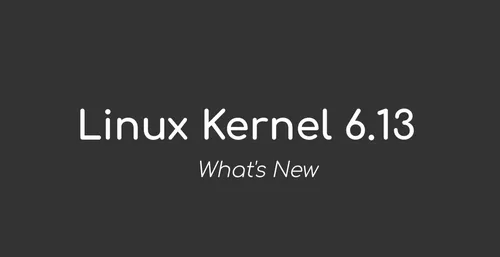Linux kernel 6.13 has been officially released. What are the new features of this release?

Today, Linus Torvalds announced the release and general availability of Linux 6.13. This is the latest stable kernel containing numerous changes such as new features, improvements, better hardware support, etc.
The main features of Linux 6.13 include delayed preemption support to simplify the kernel's preemption logic, support for running Linux in protected virtual machines (realms) under Arm CCA (Confidential Compute Architecture), user-space shadow stack support via Guarded Control Stack (GCS) on AArch64 (ARM64), support for Intel's 6-node sub-NUMA clustering, and split-lock detection support for AMD CPUs.
In Linux kernel 6.13, the amd-pstate cpufreq driver is set to default on some new AMD Epyc processors, adding support for additional thermal thresholds that can be added or removed from user space via netlink. Additionally, with updates to related libraries, new features are implemented in the character device uAPI and notifications about changes triggered by users within the kernel are sent to user space.
Furthermore, PMU support for Intel ArrowLake-H CPU and Intel Panther Lake processors, new ACPI backlight quick settings for Apple MacBookPro11,2 and Air7,2, support for the MIPI DisCo 2.0 specification in the SoundWire subsystem, a new pass-through mode for audio-related accelerators, and hardware superpages support for the V3D driver used by Raspberry Picomputers have been added.
Linux 6.13 enables the "Lazy preemption" model (CONFIG_PREEMPT_LAZY=y) on x86, RISC-V, and LoongArch architectures. This optimizes fair-class preemption by delaying preemption requests to tick boundaries. Additionally, per netns RTNL (disabled by default) for network functions has been added.
In the networking aspect, Linux 6.13 kernel converts the RTNL (Routing Netlink) lock to a namespace-specific lock, reducing contention in namespaces with heavy workloads. It also implements a new mechanism for temporarily stopping IRQs during application busy periods, allowing netlink to support per-netns NAPI settings. Furthermore, it introduces the TX H/W shaping API to control traffic shaping.
The Linux kernel 6.13 provides enhanced hardware support with updated and new drivers for various devices, including Vexia EDU ATLA 10 and Surface Pro 9 5G tablets, Adreno A663 GPU chipset, Allwinner H616, AMD ACP 6.3, Qualcomm SM8750, RealTek RT721 audio chip, NT36672A touchscreen, AMD I3C controller, NVIDIA Mellanox "MLX5" network device, and new virtual-cpufreq driver for guest kernels to improve the performance and power consumption of virtual machines.
LoongArch architecture now includes real-time computing functionality, and pointer masking support in user space has also been added. Additionally, vector misalignment access performance investigation support for RISC-V architecture with Zacas and Zabha, qspinlock support, trace event support in Rust, and a new memory allocator have been provided.
"Currently, Linux kernel 6.13 can be downloaded from Linus Torvalds' git repository or the kernel.org website. However, if you are compiling it on a GNU/Linux distribution, we recommend waiting until the new Linux release arrives in the stable software repositories of your distribution."
Once Linux 6.13 is released, the next major kernel branch and merge window for Linux 6.14 will open up. This new kernel is expected to be published as a stable version by mid-March 2025. In the meantime, the first release candidate (RC) development version will be available for public testing two weeks later, on February 2nd.

カテゴリー
最新記事
- 静かなキーストロークと高い生産性の向上を実現する、STEALTH KEYBOARD SM3 メカニカルキーボードのレビュー。
- その古い電話が目の前で火事の原因になった。
- アップル招待とアップルカレンダーの違い:10個のポイント
- アップル @ ワーク:2025年にアップルがGoogle Workspaceに対抗する製品をリリースするのか?
- Apple は iPhone SE 4 を発表する特別なイベントを開催する可能性が低い。
- 今日の NYT Connections ヒントと解答 (2 月 8 日 #608)
- Ubuntu 20.04 LTS のサポートが終了します。
- 読み込みが間に合わない? AI に読んでもらいたいですか?
- これは私が愛用する聖杯 ブルーレイプレーヤーです。
- 来週、新しい Apple 製品の発表が予定されています。詳細は下記の通りです。



